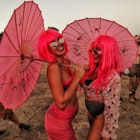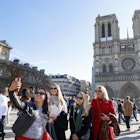

Learn about Paris' diverse communities through the city's hip-hop and rap scene © EQRoy / Shutterstock
A night in Paris I’ll never forget was seeing NTM take to the stage after a 10-year break along with 20,000 other fans who packed into the Bercy Arena for the sold-out concert.
Rappers Joey Starr and Kool Shen were reunited to celebrate their 30th anniversary as NTM, one of France’s most notorious hip-hop groups. I watched as they burst onto stage in front of a backdrop of flashing lights, to a howling crowd who nodded and rapped along as all their favorite tunes, from "Ma Benz" to "Paris sous les bombes", pounded through the sound system.

How a mix of cultures and influences make French hip-hop unique
The first time I heard French hip-hop music by groups like NTM, IAM or Assassin, was in the 1990s, while I visited cousins in Paris. I remember thinking how much more depth French rap lyrics had in comparison to a lot of anglophone hip-hop we listened to in the UK back then. It was the golden era of the movement in France, which began in the early '80s in the US with five elements: rap or MC-ing, DJ-ing, break dancing, graffiti and beatboxing.
When I moved to France, my interest in French hip-hop peaked as listening to its artists helped me to better understand how the various cultures of France fit together. The movement was already starting to lean towards the rap strand and was led by artists often from diasporas of former colonies, expressing views on the pitfalls of integration, social exclusion, capitalism and police brutality. A strong current from the Republic of Congo and the Democratic Republic of Congo arrived via Group Bisso Na Bisso in the late '90s, marking a turning point for French rap that was until then, heavily influenced by sounds from the US and UK. Artists with Congolese backgrounds are among the biggest-selling on the scene like Damso, Gims, Ninho and Niska and I was surprised to find out that Congolese rap makes up about a quarter of the business.
The arrival of the internet in the early 2000s froze the rest of the hip-hop movement in a place and time, but the rap strand pushed through and out into the world. “Artists were able to have their own blogs on Skyrock radio’s website or MySpace. They had their own platforms for the first time, meaning they controlled their image, got their music out there, and could speak directly to fans and organize impromptu concerts without the help of a label,” explains Narjes Bahhar, Senior French Rap Editor at music streaming platform Deezer France. “This resulted in self-made rappers like Sexion d’Assaut and an outbreak of many rap subgenres.”
Rap in Paris has always reflected societal shifts, with rappers singing about colonization and life in the ghetto, which helps to understand the city’s various communities. Today, rappers now come from a wider range of backgrounds and sing about topics that are relatable to a broader audience, again, reflecting how diverse the Paris population is.
Names that come to mind are solo French rappers Orelsan and Jul – I was taken aback by the lyrics, tone and poppy beat, which didn’t resemble anything I had known rap to be, which up till then was more gangsta style. Listening to rap duo PNL, whose music is defined by their voices distorted by a vocoder, was yet another revelation. “Rap culture is so strong on its own, that it’s split off from hip-hop,” says Narjes. “We now talk about rap cultures, in the plural sense, because of this hybridization of the genre.”

Where to find it
As French rap is now so diverse – with Narjes, we talk about drill, trap, Jersey, cloud, afro-rap, afro-trap, DMV flow… – I wasn’t sure I would get the same feeling as the old-school gangsta rap I like so much, nor enjoy the venues as much as the more underground places you’d have to go to for a gig.
Orelsan for instance, with his slower enunciation means greater focus on lyrics and on his reflections about society, giving us a glimpse into life here for people of his background. Other rappers like Damso, are about the lyrics and his flow but also about getting you moving and dancing. The diversification of French rap means a diversification in venue types too, from enormous arenas for sell-out shows like old-timers NTM and Booba, to multiple smaller more under-the-radar locations like the New Morning, Boule Noire, Cigale, Olympia, Elysée Montmartre, Philharmonie, 211, Trabendo, Trianon, Bellevilloise, La Machine du Moulin Rouge, as well as the Bataclan, which has just kick-started an annual hip-hop festival “Triple H”.
Rap and hip-hop artists also often figure in the lineups of various summer festivals like Paris' Lollapalooza where Damso, Niska and Doria will be performing this summer. Your best bet when searching for gigs is to look at the lineups of the various venues and festivals on ticketing sites or on Lylo.fr, which is a really great resource for all the gigs happening in town. Some sure bets are:
La Place
La Place is a hip-hop culture center in the glass structure straddling Chatelet metro station in the heart of Paris, instigated by the city hall when the area was being revived. It has grown into an organic hub with high-profile events all year long, from gigs to conferences such as the four-day L2P Convention with masterclasses, debates and talks about street cultures and the changing face of hip-hop, as well as gigs and even a performance by the French team in break dancing’s début at the 2024 Olympic Games.
FGO Barbara
A glass fronted space in the 10th arrondissement marked by one of street artist Kouka’s emblematic warriors paintings, FGO Barbara is dedicated to supporting emerging and independent artists of all music genres, including hip-hop. There is a venue for gigs, six recording studios and two rehearsal spaces. As well as hosting its own events, it also supports La Place in hosting some of its events during the L2P Convention.
Le Tamanoir
In line with the “Grand Paris”, or the expansion of the city, venues like Le Tamanoir in Gennevilliers, northwards of the ring road, are being folded into the Paris hip-hop scene. One of the more underground venues, it’s a platform for, largely speaking, urban and world music, from Voodoo rock to Comores blues, hip-hop and rap to reggae. It also hosts events and workshops throughout the week.

Artists to know
Navigating the Paris rap scene with all its currents is no slim feat, so Narjes has shared some of the rap “bosses” to know right now. There is also a dynamic scene of emerging artists like Bekar, TIF and Meryll.
Damso
While he is Belgian–Congolese, the award-winning Damso is a huge influence on the French rap scene, making him one of the most listened-to artists in the country. He’s been active since 2006 and brought to the scene by French star rap artist Booba. His lyrics are often about his love life and are infused with styles that range from gangsta to trap and even new wave, marked by beats right out of the Kinshasa music scene.
Jul
France’s biggest selling rap artist with 4 million albums sold by the time he was 30, Jul’s music is marked by trap and what’s known as "Thai beat". From Marseille, he started out in 2013 and produces two albums a year, all platinum, making him one of the most prolific artists on the scene. His album Je ne me vois pas briller (I don’t see myself shine), went triple platinum, with some of his music videos seen 164 million times.
Ninho
Ninho started rapping from age 12 in his native Essonne region outside Paris and has been officially active since 2008. Influenced by the music of the Congo, his parents’ native country, as well as trap and pop, four of his albums have gone triple platinum.
Gazo
As well as Pop Smoke, Gazo is attributed with making drill popular in France. His career officially debuted in 2019 although he started several years before under the name Bramsou. He was the first French artist to sign with American label Epic Records, that also has international rap sensations Drake and Travis Scott on its books.
Doria
An artist who became known via Instagram thanks to a post by Booba who liked her fast-paced and upbeat gangsta-style rap, Doria’s appearances on several rap shows like rapper Fianso’s Rentre dans le Cercle in 2018, Couvre-Feu and Skyrock’s Planet Rap established her on the French rap scene.
Le Juiice
A self-made rapper of Ivorian descent, Le Juiice calls herself “Trap Mama,” signaling her musical influences, and heads up her own label Trap House. After appearing on a hip-hop show, she quit her finance job to turn to music in 2018. She’s since released several EPs highlighting her focus on putting across the various cultures of Africa.
What to wear
The diversity of French rap today means that dress codes and etiquette is no longer carved out by one artist or subgenre. Each artist sets their own codes that range from the latest streetwear collabs to designer brands like Balenciaga. The best way to avoid a French rap style faux pas is to look at the artists’ social media to see what style they’re sporting.
Take it home
Most record shops in Paris specialize in various musical genres. Those with a hip-hop and rap section include Music Avenue in the Bastille backstreets of Faidherbe Chaligny. There's also a pocket of great restaurants like the Paul Bert bistro, a bit pricey but worth the spend for its traditional French dishes.
Dizonord, a play on the word "dinosaur," often hosts events, especially around Disquaire Day ("record store day," every April) and is a short walk from the Jules Joffrin station in the 18th district, where you’ll find a plethora of independent restaurants and bars, especially around rue Versigny like Patakrep for sweet and savory crêpes and La Timbale for drinks. Betino’s in the 11th is also a great excuse to also explore the neighbourhood, which is between bustling Bastille and the picturesque Marais.
Explore related stories

Art and Culture
Why France's Rencontres Trans Musicales music festival is worth traveling forNov 11, 2022 • 6 min read





 Festivals & Events8 of the best cities in Europe to celebrate New Year’s Eve
Festivals & Events8 of the best cities in Europe to celebrate New Year’s EveNov 6, 2024 • 7 min read

 ArchitectureNotre Dame reveals December opening date amid debate over entry fee
ArchitectureNotre Dame reveals December opening date amid debate over entry feeOct 31, 2024 • 5 min read
 Art and CultureFrance itineraries: 5 routes to see the best of the country
Art and CultureFrance itineraries: 5 routes to see the best of the countryOct 24, 2024 • 13 min read
